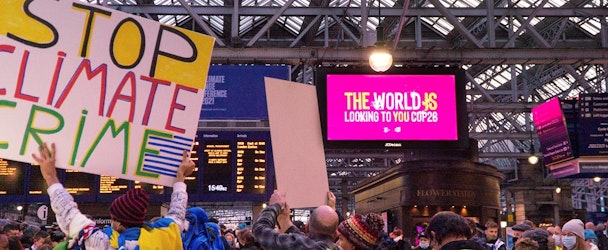‘We have a responsibility to speak out’: Iris blasts watering down of its Cop26 campaign
A Cop26 advertising campaign that was created by Iris London and designed to greet delegates to the conference by confronting them with the realities of the climate emergency was forcibly watered down by major airports and train stations for being too “political, alarming and sinister.”

Iris said the campaign copy had to change from ‘We’re watching you’ to ‘The world is watching’
‘The World is Looking to You’ campaign was live in the lead up to and during Cop26, and across all major transport hubs in the UK. The media buy by Media Bounty aimed to ensure world leaders and delegates arriving at Cop26 would be confronted with the realities of the climate crisis upon arriving in the city of Glasgow for the conference – and that the ad space was not co-opted by greenwashing campaigns by fossil fuel and energy companies.
However, as first reported by Channel 4, during the campaign’s development, Iris and Media Bounty said they experienced climate censorship from media owners on a scale that shocked both the client and agency teams.
Ben Essen, global chief strategy officer, told The Drum that at the time of production Iris was nervous about speaking out about the pushback as it did not want to jeopardize the campaign completely. But since then “we felt a sense of responsibility to speak out because we didn’t want to fall into complicity by reinforcing it,” he explained.
Essen believed it was the prevalence of the campaign, thanks to the media buy, that caused the pushback.
“Landowners came to the realization that it was dominating in the same way a major phone ad would,” he said. “That raises the question of what messages are allowed to be shared in public spaces.”
What was changed?
-
Headline copy had to change from ‘We’re watching you’ to ‘The world is watching’ to move away from the feeling of scrutiny.
-
Iris reported media owners were highly selective about what imagery could and couldn’t be used – with the concern it would be distressing to the public to see people experiencing the climate crisis.
-
The imagery that could be used was in many instances cropped “so tightly that we were left with only portraits of people – not able to show any context of their surroundings and the impact of each climate disaster, e.g. drought, flood, fire,” Iris said.
-
In some instances, the agency said it was prevented from using any imagery at all and resorted to a copy-only route.
-
It was also unable to use URLs or QR codes that would enable it to tell the human stories behind the crisis.
Essen said the implication from media and landowners that resisted the campaign was that it was “too political.”
“We ought to have long moved past the idea that climate change is political,” he continued.
While initiatives like the CMA’s Green Claims Code to crack down on greenwashing in advertising are welcome, Essen worried it may push advertisers “too far in the other direction, where they are fearful of communicating on the subject at all.”
“I think we need greater clarity on what we can as well as can’t say, because there’s a separate element to the issue of this campaign, and that is one of representation,” he added.
He concluded that the “great failure of Cop26 was that the climate justice agenda was not moved forward.”
As Iris’s campaign sought to highlight the realities of the climate emergency for the way it will affect people in the Global South, Essen said that the future of climate advertising is one that also affects the conversation around diversity in advertising.
“We need to not only show what stories we are telling, but who we are representing and that is why we have chosen to speak out.”

